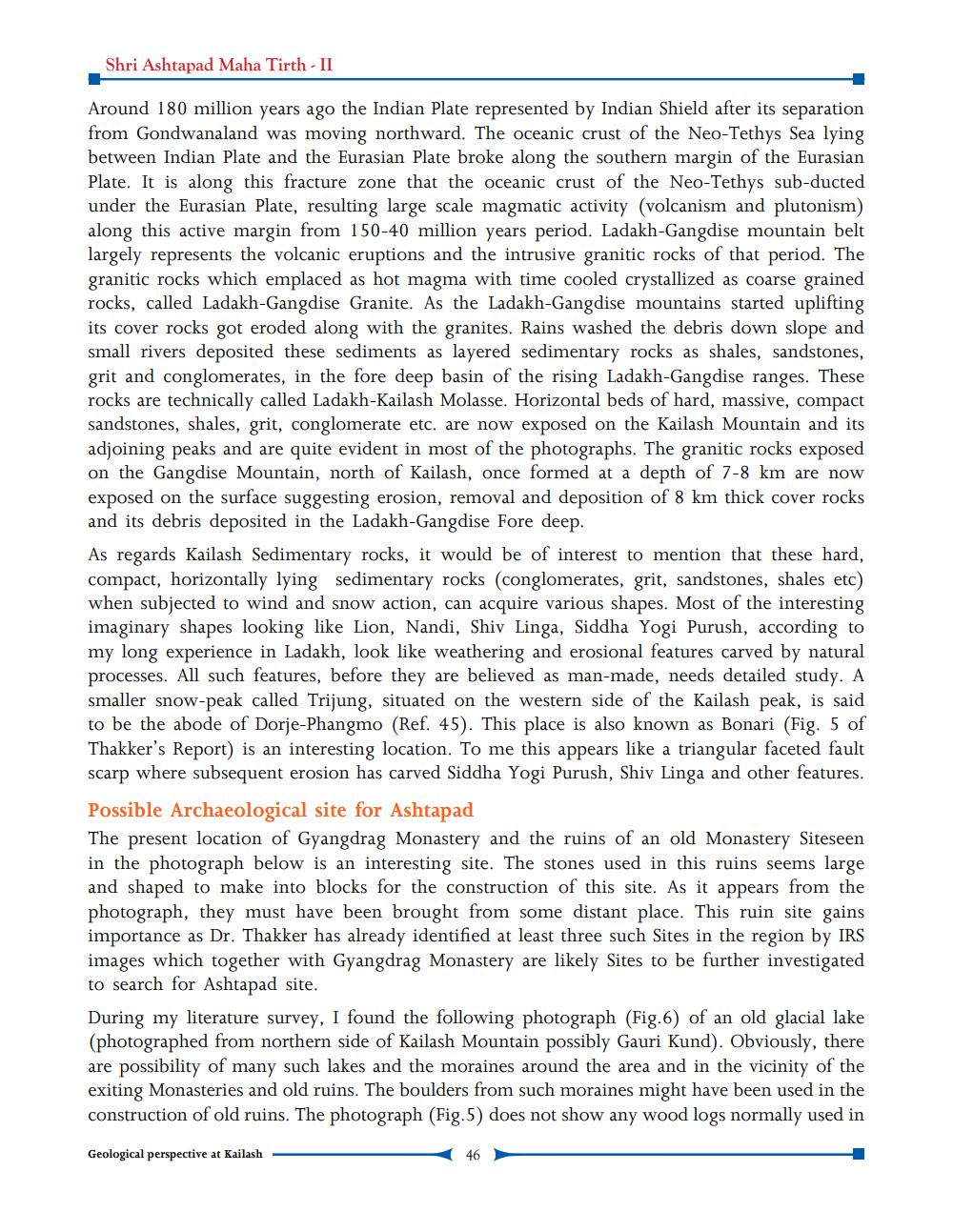________________
Shri Ashtapad Maha Tirth - II
Around 180 million years ago the Indian Plate represented by Indian Shield after its separation from Gondwanaland was moving northward. The oceanic crust of the Neo-Tethys Sea lying between Indian Plate and the Eurasian Plate broke along the southern margin of the Eurasian Plate. It is along this fracture zone that the oceanic crust of the Neo-Tethys sub-ducted under the Eurasian Plate, resulting large scale magmatic activity (volcanism and plutonism) along this active margin from 150-40 million years period. Ladakh-Gangdise mountain belt largely represents the volcanic eruptions and the intrusive granitic rocks of that period. The granitic rocks which emplaced as hot magma with time cooled crystallized as coarse grained rocks, called Ladakh-Gangdise Granite. As the Ladakh-Gangdise mountains started uplifting its cover rocks got eroded along with the granites. Rains washed the debris down slope and small rivers deposited these sediments as layered sedimentary rocks as shales, sandstones, grit and conglomerates, in the fore deep basin of the rising Ladakh-Gangdise ranges. These rocks are technically called Ladakh-Kailash Molasse. Horizontal beds of hard, massive, compact sandstones, shales, grit, conglomerate etc. are now exposed on the Kailash Mountain and its adjoining peaks and are quite evident in most of the photographs. The granitic rocks exposed on the Gangdise Mountain, north of Kailash, once formed at a depth of 7-8 km are now exposed on the surface suggesting erosion, removal and deposition of 8 km thick cover rocks and its debris deposited in the Ladakh-Gangdise Fore deep. As regards Kailash Sedimentary rocks, it would be of interest to mention that these hard, compact, horizontally lying sedimentary rocks (conglomerates, grit, sandstones, shales etc) when subjected to wind and snow action, can acquire various shapes. Most of the interesting imaginary shapes looking like Lion, Nandi, Shiv Linga, Siddha Yogi Purush, according to my long experience in Ladakh, look like weathering and erosional features carved by natural processes. All such features, before they are believed as man-made, needs detailed study. A smaller snow-peak called Trijung, situated on the western side of the Kailash peak, is said to be the abode of Dorje-Phangmo (Ref. 45). This place is also known as Bonari (Fig. 5 of Thakker's Report) is an interesting location. To me this appears like a triangular faceted fault scarp where subsequent erosion has carved Siddha Yogi Purush, Shiv Linga and other features. Possible Archaeological site for Ashtapad The present location of Gyangdrag Monastery and the ruins of an old Monastery Siteseen in the photograph below is an interesting site. The stones used in this ruins seems large and shaped to make into blocks for the construction of this site. As it appears from the photograph, they must have been brought from some distant place. This ruin site gains importance as Dr. Thakker has already identified at least three such Sites in the region by IRS images which together with Gyangdrag Monastery are likely Sites to be further investigated to search for Ashtapad site. During my literature survey, I found the following photograph (Fig.6) of an old glacial lake (photographed from northern side of Kailash Mountain possibly Gauri Kund). Obviously, there are possibility of many such lakes and the moraines around the area and in the vicinity of the exiting Monasteries and old ruins. The boulders from such moraines might have been used in the construction of old ruins. The photograph (Fig.5) does not show any wood logs normally used in
Geological perspective at Kailash
46




